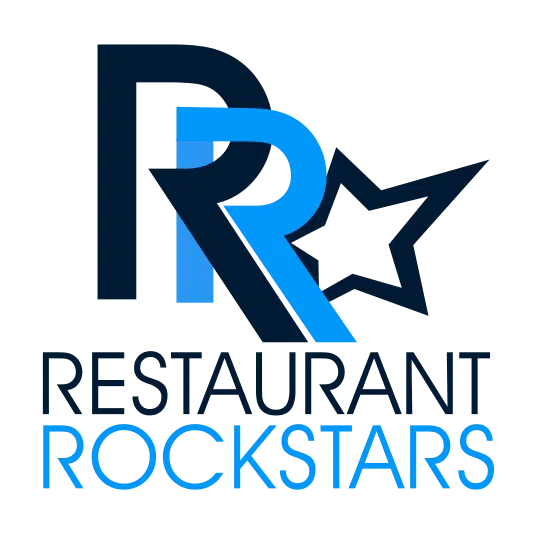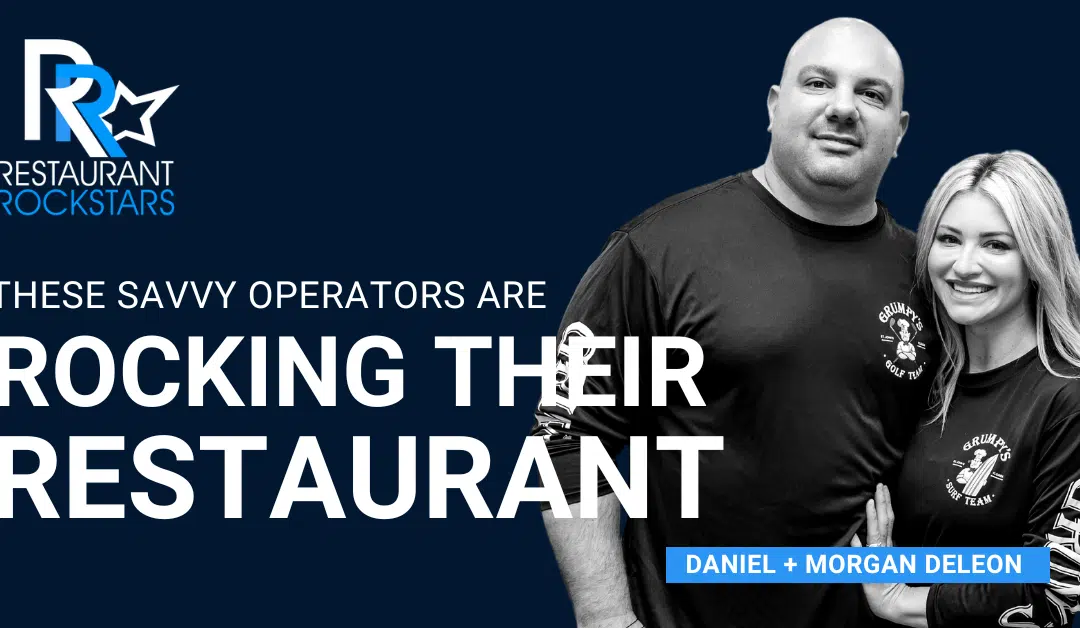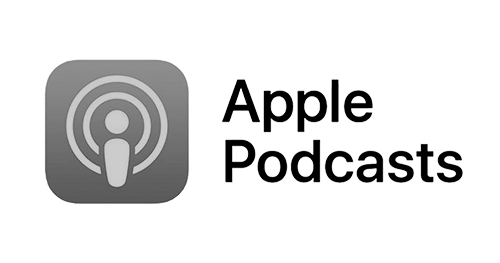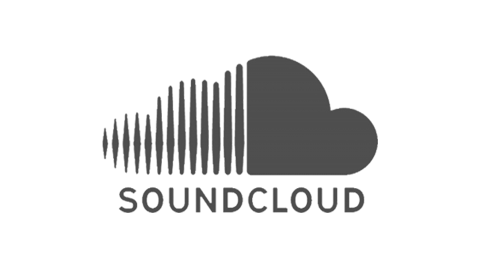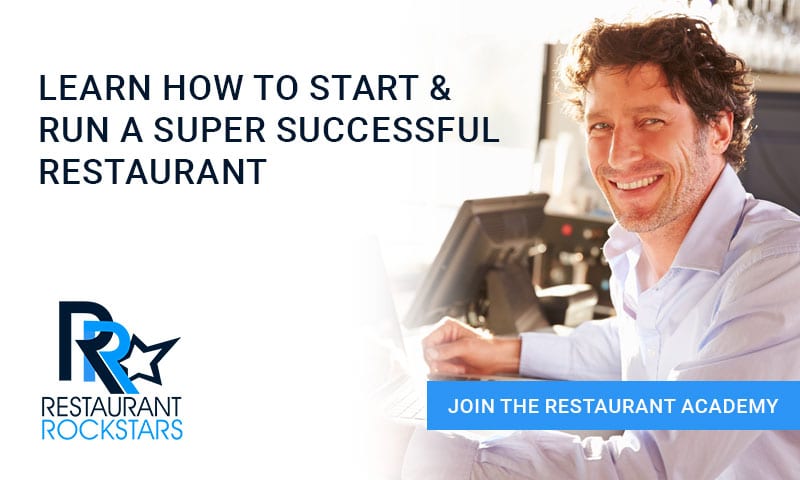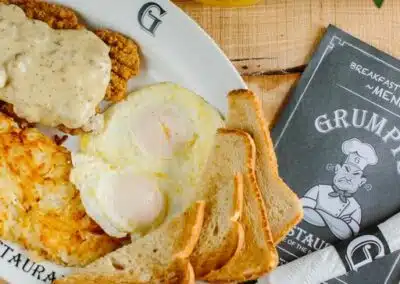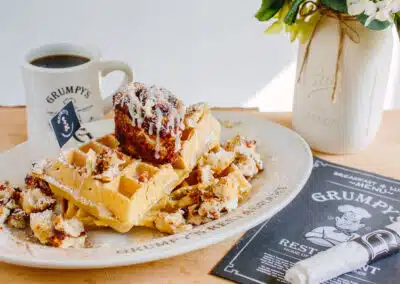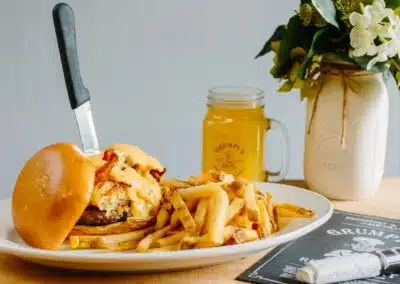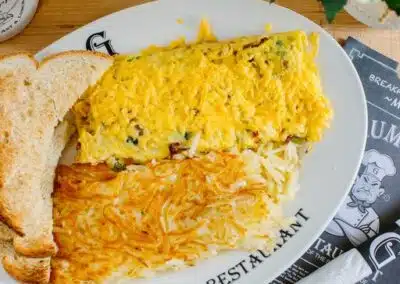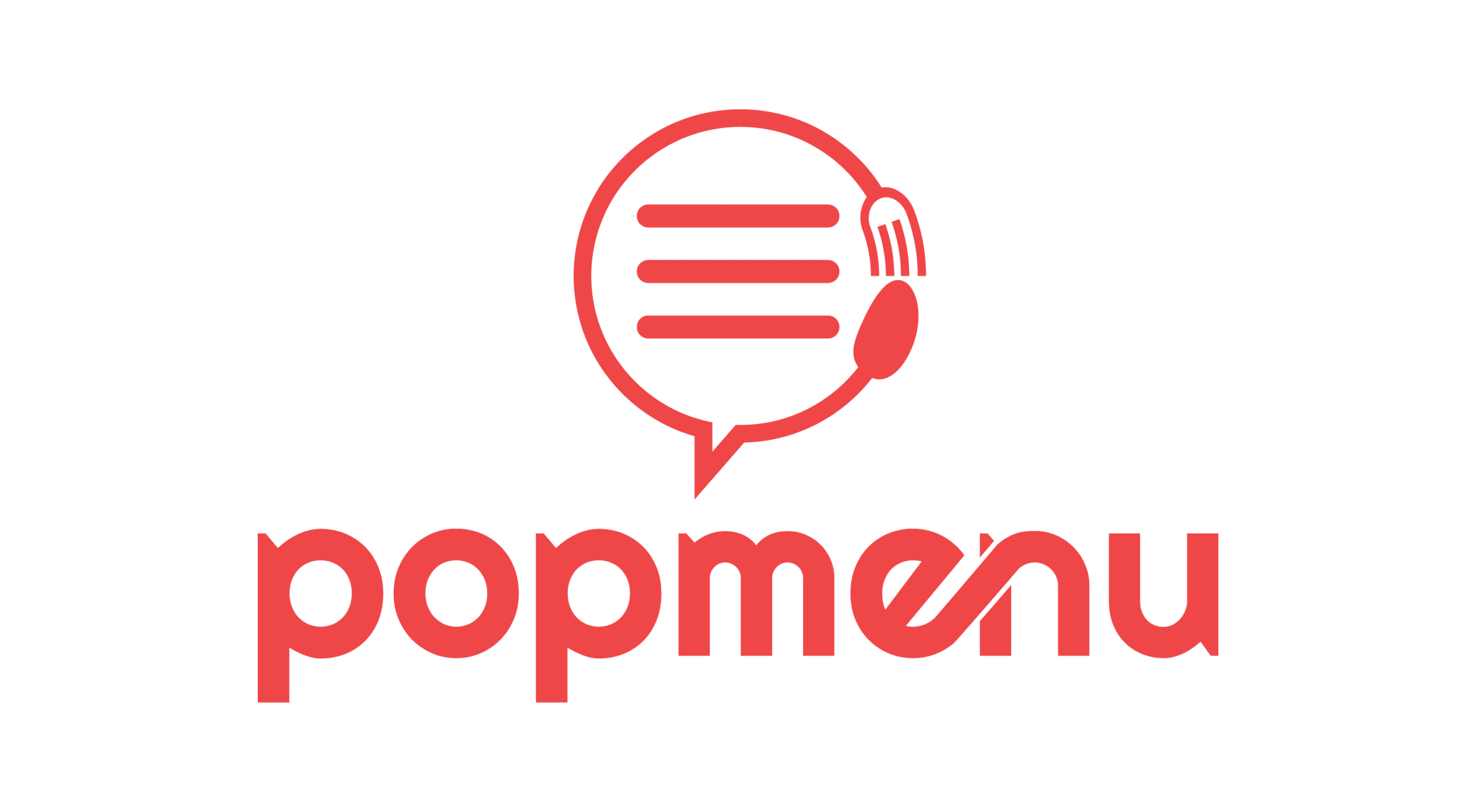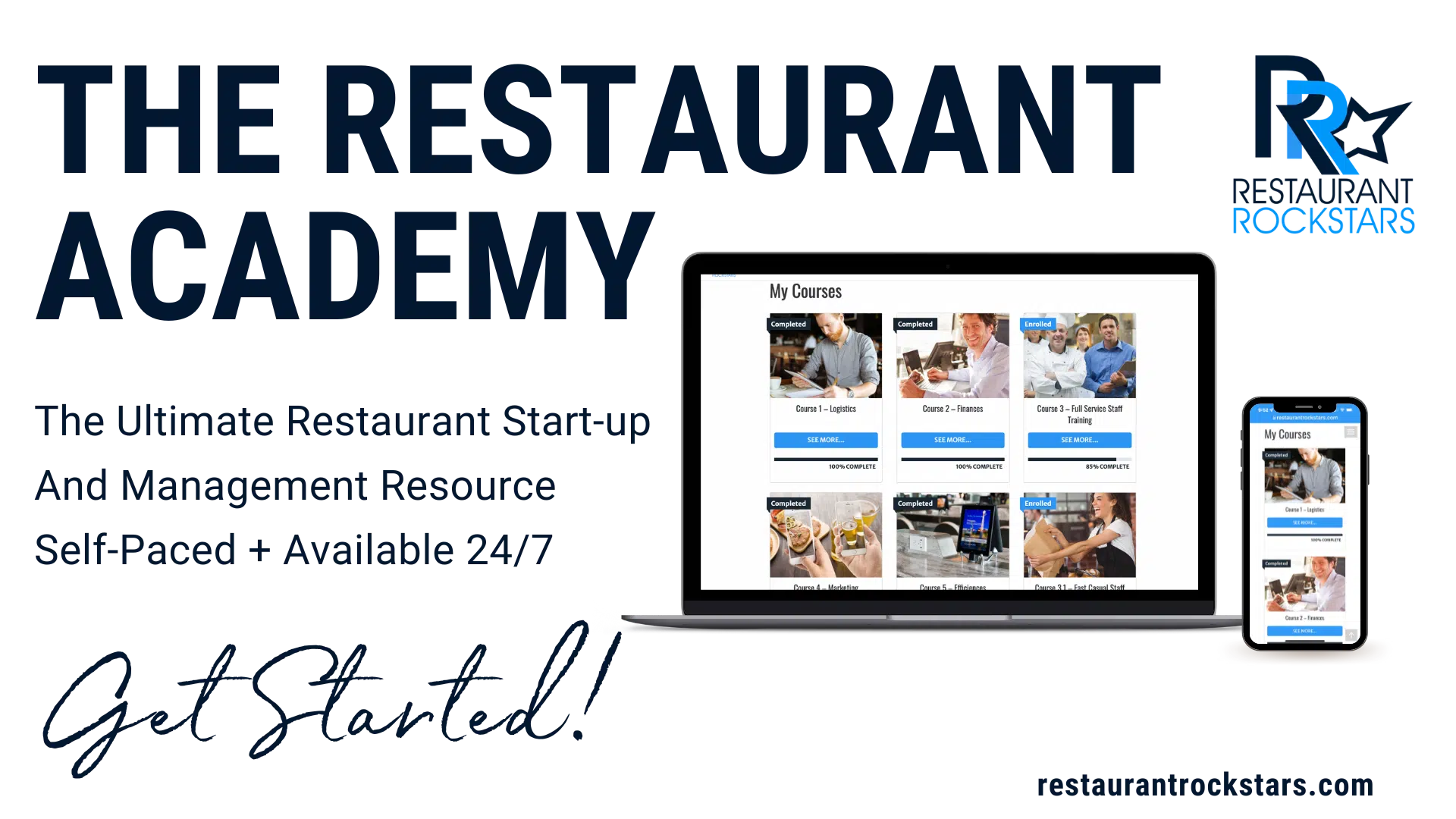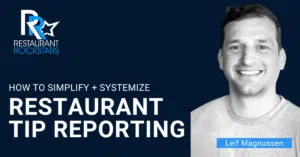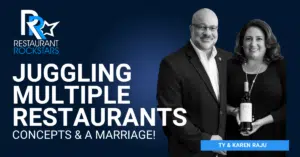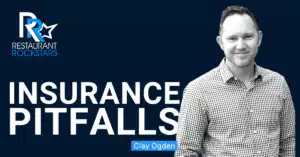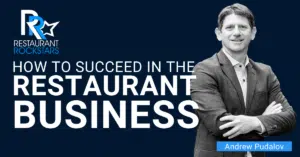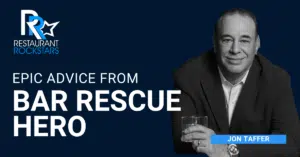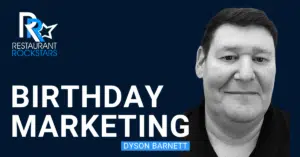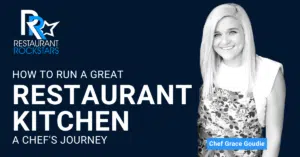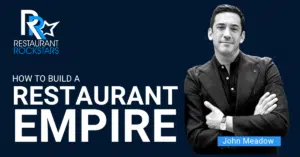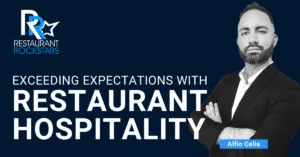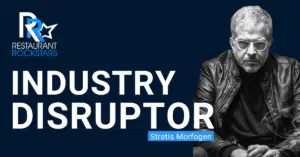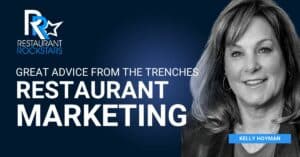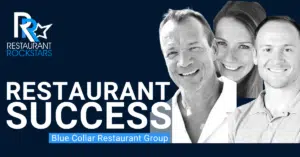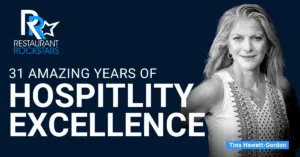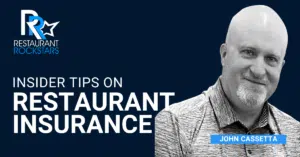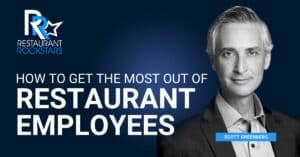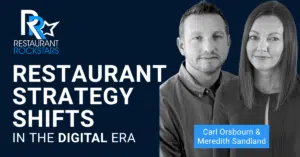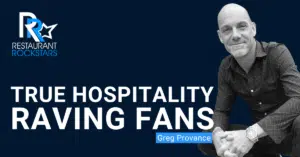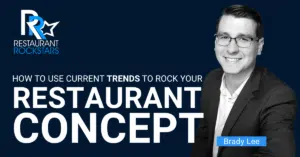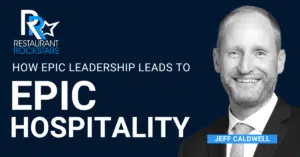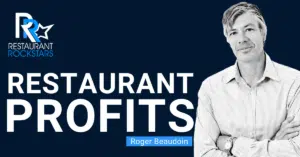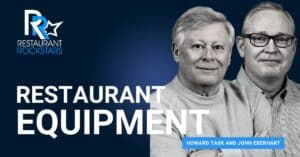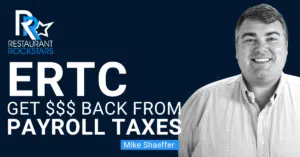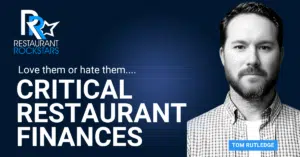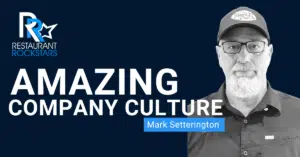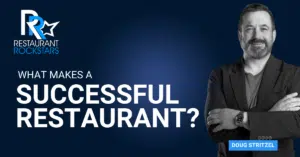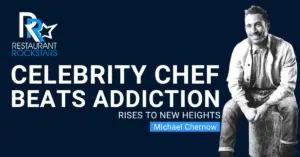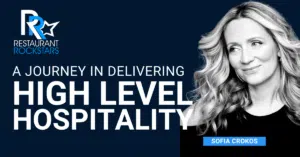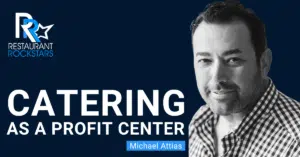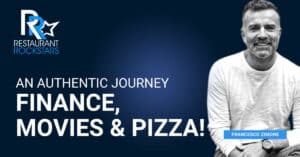Restaurant Rockstars Episode 357
Savvy Operators Rock Their Restaurant Business!
LISTEN HERE OR ON YOUR FAVORITE PODCAST PLAYER
There are operators who are running restaurants and those who are running businesses, these are two very different approaches.
In this episode of the Restaurant Rockstars Podcast, I’m speaking with Dan DeLeon of Grumpy’s Restaurant Company, a full-service breakfast, lunch & brunch concept that is really rocking it.
This winning franchise starting with a tired restaurant that had a good name but had changed hands a few times and needed a complete makeover.
Dan and his wife Morgan, who is the V.P. of Operations, used their prior experience to work “On” their business and not just in it. Now they have a big picture outlook on steady future growth as they continue to add new units to their company!
Watch or listen as Dan talks about:
- The importance of business acumen and prior restaurant experience to grow a concept.
- Having a vision for what could be and then methodically executing all the details.
- Going home every day after 2 PM to family and not being “tied” to the operation.
- Grumpy’s winning restaurant company culture and core values.
- Knowing your customer and honoring their values and expectations
- How Grumpy’s maintains margins while keeping prices reasonable
- Keeping ticket times in line and maximizing table turns
- Their successful retail merchandise program as a “brand builder”
And of course, being family friendly and always “giving the people what they want”!
Don’t miss this episode, go out there and ROCK your Restaurant!
Roger
Connect with our guest:
https://www.grumpysrestaurantco.com/
https://www.instagram.com/grumpysrestco
https://www.facebook.com/grumpysrestaurantco
https://twitter.com/GrumpysRestCo
Welcome back. Thanks for joining me. Today’s guest is an inspired leader that has a tremendous amount of experience in the hospitality space. It started with finance. But he found a passion for restaurants he and his wife, they took over an existing concept that had been multiple ownerships and they rebranded and they literally started with a blank slate and now they’re franchising this business. And there’s so many key learnings here, but literally hospitality leadership, staff training quality, reasonable prices, portions, but all the systems about working on your business, not in it so that you can grow a business, but also find the balance here. They’re doing breakfast, lunch, and brunch, which allows them to spend time with their family after hours, afternoons and evenings dinners at home. Dan, my guest is coaching his you know, his daughter’s teams in his in his son’s teams, and it’s rare in this business to be able to find that kind of balance. So I’m speaking with Dan from a concept called grumpys you’re not gonna want to miss this episode. It’s got everything. Thank you to our sponsors for this episode. You don’t want to miss this. So listen on.
You’re tuned in to the restaurant rockstars podcast, powerful ideas to rock your restaurant. Here’s your host Roger Beaudoin.
Listen, when I ran restaurants, I had my core values, the things most important how I ran my restaurants, monitoring daily operations, training my team for consistently great guest experiences food safety, quality assurance and preventative maintenance. All this took a system. Well, here’s what Xenia can do. Xenia gives you a modern app, really an operational Basecamp that scales standard operating procedures, trains, your team controls, operations, and even manages food safety. Now I really like their sensors that continuously monitor temperature for fridges and freezers so you can proactively prevent inventory losses. Now, how valuable is that? Now whether managing a single or multiple locations the Xenia app helps you ensure consistency, compliance and accountability across your operation. You can see full detail in real time from anywhere in your Xenia dashboard with automated reports right to your inbox. Now again, this was vital in my restaurants. Now until September 7 Xenia is offering my listeners 20% off Xenia starts at just $69 per month per location. So get my special deal at Xenia.team/rockstars Xenia is spelled Xenia.team/rockstars.
There are many elements to consider when growing your restaurant. are you connecting with diners enough and with the right message? Could your kitchen be putting out more orders than your dining areas have room for? Well, it can be overwhelming especially when the reason you got into this business is for the food and the people. That’s why restaurants get pop menu. Pop menu is the marketing tech platform designed to make growing your restaurant easy, so you don’t have to grow it alone. With pop menu you can capture more guests and their preferences through your restaurants website that’s designed to easily collect contact information and data so you can see what your guests love and why they dine with you. Connect and build authentic relationships with guests by using modern technology that personalizes marketing. Make all your systems work better together, improve margins and conquer the chaos of your restaurants digital presence pop menu has a special offer for my listeners. For a limited time get $100 off your first month plus lock in one unchanging monthly rate at pop.menu.com/rockstars go now to get $100 off your first month at popmenu.com/rockstars.
Dan, welcome to the restaurant rockstars podcast. Thanks for being on the show.
Yeah, thanks for having me. It’s a pleasure.
Well, we’re gonna talk all about Grumpys and your success with your concept. But tell us first about your hospitality backstory. Where did it all begin for you and how did you get into this business?
Well, I got into this business after college. I was a financial advisor I went to University of Florida and it really wasn’t what I thought it was going to be I thought it was going to be the Wolf of Wall Street and be an investment banker and do all that good stuff but I was here in Jacksonville working for Merrill Lynch and I thought you know, I wanted to own my own business and do something more and explore my entrepreneurial spirits and I became a franchisee with a company called Pita Pit and then from there blossom into another concept so I own multiple units of that have other concepts. And then the road took me to selling you know my interest in in my other franchise I was with and then going working for RBI. The company owns Tim Wharton’s Popeyes Burger King. And then going on from there, you know, I thought I could do it on my own, I thought we could make a great brand. And so me and my wife took that leap of faith purchase grumpies and turned it into what it is today.
Now, that’s fantastic story. So you’ve got the financial acumen. But you also worked for some of the leading franchise companies out there. So you kind of had the framework in mind and what you had to go through to set this up as a franchise and then obviously sell franchises and be successful with that. So grumpies was an established business and how many units did it have when when you got involved?
When we got involved? Grumpy is actually a restaurant here since 1999. And it had changed hands six or seven times here in my local area. Yeah. And change visions a few times also dinner restaurant, they tried to do a French bistro. So really, when we purchased it, it was really facing closure. And we, you know, did a total overhaul resurgence of the brand we went, you know, we took it back to just doing breakfast and lunch American style, traditional Americana. And everything we did we set up a replication because at the same time we were we were developing, we’re launching our franchise program, we tripled sales in less than two years, and launched our franchise program. We’re now we have five units open.
Oh, wonderful. That’s, that’s terrific. So what was the trajectory of opening the new units based on? Okay, I heard you had a blank slate, pretty much, obviously, the price was right, because the place was on the verge of closure, you kept the name. And then you expanded and really built a brand into more than much more than what it was. So how long did it take you to go from say, one to five units.
So from going from one to five units, it took from 2018 through the pandemic, and today we actually open stores, you know, through the pandemic, we really didn’t start franchising till 99 2019. Really, we launched in 2019. But we didn’t, you know, officially start really getting geared up until 2020. And then opened our second location, we have four franchise owned locations. And we’ve just been rolling them with a goal of you know, one to two a year, and then moving to where we are today. But you know, even if we don’t hit that, you know, timings always wild. So some stores that we’ve done with with developments. You know, it’s tough to get those new store developments in strip malls or shopping centers, you know, to be on target in on that timeframe. But it’s been good for us, we’ve used that to our advantage, so we can plan and utilize our resources, you know, mostly manpower in people power.
Now you’ve clearly built a brand here. So let’s talk a little bit about that. Again, we kept the name grumpies. And it’s sort of an irreverent sort of name and there’s a grumpy in the kitchen. But you’ve got a tagline where everybody leaves happy and all that kind of stuff. But as a blank slate, like how did you market this business? And how did you change the vibe and the sort of aura around it to create the buzz that you did to then be able to sell the concept to others even though you’ve you’ve dialed in the original location, which we’re going to get to but tell us about the process of of creating a brand because it’s so important to a restaurant. I’m a huge believer in not running a restaurant but building a brand. And that leads to so many additional profit centers and it leads to social media, and people really feeling a part of that brand and that’s what we call affinity. But tell us what your process was to do that.
Yeah, definitely is what we did you know, we’re strategic from the beginning. So we thought grumpies had a good name grumpies restaurant home in the bad mood Dude, we brought in the tagline “No one leaves grumpy”, right, we updated and recreated the logo and the grumpy character and all all of the good stuff around that. And then we launched marketing program and and merchandise lines with that grumpies brand. We’ve taken that grumpies logo in house to a very detailed branding on our China platters, coffee mugs, cups, silverware, roll napkin bands, and grumpies little mini flags on pancakes to really lift off the branding, right? To get the branding and the awareness really for all those things for being social media worthy, right Instagram worthy pictures with our logo in the background logo on the platter. And then playing off of the character right we launched multiple other merchandise brands off that we have our fishing team. We’re grumpy holding a fishing pole. We have our grumpy, strong or grumpy he’s you know got a shirt ripped off and flexing there. So we have a few Yeah, absolutely. We have a few other lines that are hunting club, our surf team, you know our golf club. Yeah, all Florida Bay, like very Yeah, absolutely. And then it’s a great grumpies character that the children like right, the coloring menus and things like that i grumpies we If the grumpies tattoos for all the little kids that come in, so we really play off of that branding and marketing early, right, what we didn’t have, when we first took over, we noticed we had a great retiree base, customer base, and working class. But we didn’t have a lot of families or the younger demographics coming in. And we’ve really updated the menu and things to make more Instagram worthy type cooler items to to impact the the children, the younger demographic. So we have a little bit for everyone. And we’ve read that really helped and work really good in building the brand and building the brand awareness and then turning our culture into what it is today, right?
You know, that’s so smart. I had a family oriented, a series of concepts as well. And we always believed that if you serve families in general, that the kids often determine where they want to go to eat, and they tell the parents, hey, let’s go here because we want to go to the fun place, and they often dictate where the family eats out. So if you capture the kids attention, make it super fun for them. That’s like marketing unto itself, because the kids market the business for you. And that’s obviously what’s happening for your business. The tattoos is a great idea. You know, that’s, that’s terrific. We stepped Dum Dum lollipops in the treasure chest and kids prizes. And we had a woodfired pizzeria. So we give them pieces of dough to play with. And we went so far as to create a kid’s camp on Sundays, where we had a camp counselor that was entertaining the kids while the family while the parents were dining, we had arcade games. It’s like the cranes and the candy, and all that kind of stuff. It’s like you can’t do too much for the kids. And it’s a huge boon to the business. And you’re obviously tapping into that. That is super cool. Now you made a decision. You mentioned that grumpy sort of changed concepts here and there, and you guys made a decision to do breakfast, lunch and brunch. Can you explain why and you’re obviously finding that to be super profitable segments. But there’s another reason as well, right?
Yeah, huge order. A huge reason for us is quality of life. Right? Not only do I love the breakfast, lunch and brunch, space, and food and menus and American style, route 66 style diner food is something that I like and feel passionate about. But also, you know, it’s really big fries for quality life. And our franchisees, you know, I coach my kids sports pick my kids up from school every day. So dinners is not in the cards, right? We we want to be home at that time and with our families. And we think it just has such a valuable aspect to the industry to do that and have those limited hours, you know, it creates a little bit of novelty to makes it more of an experience. Some people can’t come to us, right only those days off of work because government holidays and things like that, or on the weekends, which we love that we think that’s really cool, too. It builds the helps build the buzz and excitement around the brand. But mostly for us. It’s that quality of life and family time that we just don’t want to miss out on.
Thank you for sharing, because that is so rare in this business. There’s so many operators out there, where they’re not running the business, the business is running them in seven days a week, it’s long hours, it’s all day, it’s late at night, it’s like you’re missing your kids grew up graduations, their soccer games, all that kind of stuff. And you made a conscious choice to say no, I can find a balance in my life, I can have a successful business. But I think we’re touching on systems here because you wouldn’t be able to have that big picture 30,000 foot view of your business if you were working in it you worked on it created a concept and now you’re franchising it. And you’ve got the best of both worlds, you’re building a successful business you’re you’re finding the right people that follow your philosophies, the guiding light of what this business, you know what its core is all about. And you’re duplicating that. So there’s a huge lesson there. Were there any challenges, at first in say, creating these systems? Because you’ve seen it all before with some leading companies, but what were some of the challenges on your journey to getting to where you are today, if you remember those
a big challenge and replicating our exact system here from our from our flagship location is this lens has been a restaurant for over 50 years. So it actually started off as a house. Three additions, right? So it’s, it’s not laid out as you would ever decide to build anything, you know, and we’re limited in what we can do in the kitchen
a little disjointed and it’s not perfectly designed.
No, not at all. I mean, when we first took over the third one of the third editions in the back of the building is where they put the dish dishwashing area the dish pit right. Yeah, there was floor drains. And I’m looking around like what’s going on here when they do it the water out back and you know, so we had that’s one of the first projects we took on is tying into the existing plumbing and we got it as good as we could we were able to put some trench drains and everything that’s it’s really neat in a dish bit. But the fall is not great. You know, guys who are and girls have done the operating know that they know what I’m talking about when they hear that they know what they experienced. So we got it really good, we have actually everything working awesome. But challenge being we knew when we go to a newer space, let’s say an endcap of a strip center, the cook line is going to be a little bit different of a design instead won’t be chopped up, it’s going to be a 25 foot cook line right to be more efficient assembly line style, a little bit different than our flagship location, we get the job done a year. But and it would be awesome if we had that extra eight, nine feet right to have our cook line just continuous, instead of a little bit around the corner and in the prep room down, two steps in to the side and the dish from down another step and in the back. So it’s all it’s fun, it works. If people come see the site, they’re gonna say how this is insane. You know, how we do the volume we do out of out of this location, the other ones, they see the kitchen dishwashing area how the EU works and everything conveyer double conveyor dishwasher machines, right, we don’t have the luxury of having that little bit more old school here, right? A little bit more labor love for everyone, you’re rubbing shoulders on the on the line, like you wouldn’t believe we’re tight, right. But there’s just no way way to change it currently, unless we do you know, close and scrape and rebuild and things like that. But when you’re starting and you have this location, that such a neighborhood setting, we really don’t, we don’t want to move, right, we don’t want to go to another location and build your traditional, you know, sterile environment, we liked the character, we like having to make it fit and make it work a little bit. So people will call me crazy for taking that on. Right? They just want to base rectangle, stamp it in boom plans go We’ve plans from each site to everyone. But for us, it’s okay to be a little bit different and fit the neighborhood setting that we’re in. I actually would prefer that and like that.
Now, miles good, right, you got history, you got tradition. And now it’s fun. I mean, it works, you’ve proven that it works. And you know, it doesn’t have to be the year the model for obviously the stores. But now knowing what you know, and you’re designing stores for maximum efficiency. But it’s really cool that you can go back to the character of this is where it all began. And we keep it because tradition history and we like it just the way it is. And there’s a marketing story in that too, you know?
Oh yeah, absolutely. And then also it’s a testament to our to our team members. Because we you know, we have some of the optimal locations right designed on paper, perfect cook line, brand new equipment, perfect. Everything right 25 feet of hoods, 25 and a half feet of a cook line, we have everything, additional grill, additional kts screens, you name it, double the amount of fryer space that we currently have, somehow, we’re able to hear hit the same numbers, if not better, than those amazingly set up stores, that’s really a testament to our group,
it is you know, sure,
we’ll always do a lot a lot of the training here. But then, you know, our franchisees and in their team members will moonlight at the newer locations also. So they can see exactly what their layout is going to work. But the flow is the same, right? The cooking is the same, the quality is the same, the communication is the same, the assembly lines, the same little bit smaller of areas. So you got to be really good. I call it Tetris, you know, trying to put your pancakes down on the grill, find the spot and just you know, it’s it’s fun, it’s that short order cooking, it’s the hustle and bustle. And then you know, our our teams do really well and they feed off of that they feed off of competing with the other locations that have that second fryer, and that extra 36 inches of grill space, you know that we’re not able to afford here. So so it’s a cool, it’s a cool thing to see. And then we were able to do our Neptune Beach location a little bit like that to change it up a little bit. And it works really well also,
to the different locations take on the character of the local communities in any way. Obviously standardization is very important in a franchise, you got to have consistency of menu, consistency of decor, making sure that the experience is the same from Jacksonville to Neptune to here to there and as you grow, but adding a little community flavor works to and then having certain autonomy. Let’s talk about consistency versus autonomy. And what these franchisees can do that just adds to your brand versus detracts from the mission.
Yeah, so we have the basic concept of grumpies right breakfast on some brunch, we have the set menu, we have all the operations and that you would with a very standardized franchise concept. But what we’d like to do is really listen to our franchisees and the communities that are in are going into right for example, you know, at our Neptune Beach location, big thing for us was to have a bike ride It’s at the beach population, it’s very travel cruisers, we needed to space for the bike parking, you know, here in Orange Park, or our Middleburg location, not really a big demand. Okay, so we got to look at our what can we do different there, on an exterior standpoint, you know, we have a couple golf cart parking spots, because there’s a lot of golf cart travelled in that area. And then going in, we really tried to adapt to the population, if there’s a big Jewish base population, we want to add more Jewish facing items, maybe more lox and bagels, expand the bagel profile and the menu there to get maybe a better product, if we can in any way, but give more than options, you know, we’re going to bring in the same, we’re gonna we’re gonna bring in those things that we typically might not offer at the other locations, but their demand in that market. And then we’d like to play it off of the existing location and what’s there when we do the design, the you know, the Custom Tables, and booths, you know, our interior build out, we really don’t want to go and just blanket have one blueprint, and stamp it out. Even if it’s changing a little bit from location to location, the floor plan a little bit, we don’t want it to look just like a sterile, new, modern, boom space, right? I won’t say any competitors, but you feel like you’re just kind of there. And there’s not that character, there’s not the hustle and bustle, it’s not as loud. You know, there’s, there’s carpeted surfaces, there’s things of that nature, you’re gonna see, we really try to create that environment where you feel like you’re kind of at your grandma’s house, a little bit, little different
food and a cold space, I get
it, nothing’s too nice, right? Like, even when we make like our boots, everything’s custom made to fit the location. So price tags premium, but they come out weathered, right, because we know, once we get moving, we have a lot of kids we have evolved, things are going to get beat up a little bit. So if if it’s InDesign to be strong, and other that, you know, it’s, it’s really big part of what we think about in the beginning. Because I’m a little bit OCD, I would like everything white and perfect. But knowing how things will turn out in a month, three months, a year, a couple of years, we try to play off of that from the beginning. So we do have a little rustic, shabby chic vibe to it. And it’s like a nice southern farmhouse, and grumpies and it just really feel comfortable.
That’s part of the brand. Also a little patina never hurts, right? Never spanking new, but then it looks like it’s been worn and used and traditions and generations have been here, all that stuff. That’s very
definitely. So when you’re here, you know, and your child would still drink or something. That’s the big deal, right? It’s not too nice. It’s not Oh, my goodness, you know, everyone’s in trouble. We’re just go with the flow, right? You know, you can’t hurt, you know, we know. But then again, I’m on that, that other side where I’m very big on the standards, right? So we may have custom deviation to the menu and custom things in the area. And we’re changing things, or even a franchisees favorite, right, we have no problem putting that on the menu. If that’s a custom creation, and it’s great. Let’s do it, right, you love it in your area. Let’s run it. So I’m really big on that, but very, very strict on the brand standards, quality, quality of service, quality of the food, portion size, things of that nature, we do we do get a lot more involved. And we really want to keep that as high as possible.
Let me introduce you to go tab. Go tab is a restaurant commerce platform with a suite of solutions including POS online ordering, mobile pay, and even a kitchen management tool. Now you know I’m all about maximizing sales. But did you know that operators using the go tab platform see 35 to 50% Higher check averages and 20% Higher tips? Wow, that can be a real game changer to your bottom line. Now the go tab platform empowers you the operator to run a leaner and more profitable business. Listen to what some current goat app customers have to say. Kent says with real time analytics we can manage our plate costs. When we switch to go tab we were able to lower our labor cost and increase wages in shares that our chefs and managers love to use go tab. The back end is well thought out intuitive and easy to use. While Kim adds that the Go tab team is always available for us and extremely responsive. Now go tabs flexible, easy to use solutions will simplify your operations putting you in control of your restaurant success. Visit gotab.com/rockstars today to sign up for a free demo and get qualified to receive a complimentary meal. That’s gotab.com/rockstars
I’m really glad you mentioned that because again, part of the systems is cost controls maximizing profit offering value to the guest all those sorts of things. And one of the biggest deviations in our business that isn’t taken totally seriously by a lot of operators is the standard of poor motion controls, you got multiple people making the same thing. And this goes back decades ago, but I had a woodfired pizza as I mentioned to you. And one day I’m watching shortly after we opened and, and we had one size pizza because we tried to be traditional to Italy where you get a one size personal pizza. Here, I noticed one person’s putting 10 pieces of pepperoni on that pizza and other person I counted as 12. And then there’s 14, I go to my kitchen manager Mike, how many does the recipe call for she’s like 10. And I’m like, Well, every time Bob and Sally or whoever they happen to be put two or three or four extra pieces of pepperoni. And we’re selling hundreds of pizzas a day, because it was very busy place. I’m thinking God, how’s that impacting our food costs, and how’s that lowering the profit and every pizza we sell. And it just we had to systemize that and we had to systemize every menu item. So that, okay, here’s the recipe card. Here’s the photograph of what it looks, this is what it calls for. And then we had check and balances. We had multiple people checking everything on the line, making sure that everything met that standard. And the quality was there. The presentation was there. But it was to recipe and to standard, you know, and that’s a small thing, but it adds up over huge over time. Oh, and also
turnover, it turns into a big thing. Right, right. And even so our philosophy on portion size and things of that nature is, you know, we one of our one of our mottos and and you know, kind of our mission and in our mission and vision statement is to serve a working persons portion at a working class price. Yes. So a big part of our side orders and things of that nature is, you know, how big is the portion? Well, the portions always cover the plate, right? We’re not going to get smaller plates. So we need bigger portion. So our portion control is a little bit different. We hire new Backhouse employees, they are really hesitant to put our portion size on the plate, because they’re not used to filling the hole spatula. Right? On the right. Yeah, it’s supposed to Oh, yeah, mounded up, you know, you know, they’re not used to throwing away things. When a mistake is made, let’s say a steak a little bit too burnt on one side, right? It’s supposed to be medium, it’s definitely well done, don’t flip it and sell it, throw it out. And they get, I mean, I have to, like, convince them that starts coming out of their paycheck, I promise you, it’s okay. We would rather remake it correctly. And give it to the customer hot, ready, and perfect, then try to flip it over. Right? You know, a lot of people, a lot of businesses and restaurants that I’ve been around in a lot of employees over the last 15 years would say, There’s no way none of my managers would ever let us start over. And like do, hey, you aren’t losing so much by giving a poor product to a guest who’s already in your four walls. You know, they don’t understand how hard it is to market and bring in new customers. So the ones that we have, we have to be great all the time. And it’s kind of the same thing I preach with my son’s youth football team that I coach, right? Greatness is everything, you have to be great all the time. Individual greatness, you know, is always always the standard. And same thing that I approach, a fry, cook a dishwasher anything, take pride in what you’re doing, keep the quality very high. And then you’re kind of multiplying your odds of success, right in anything that you do. But for us, we push it in the food industry, or we push it on the football or baseball field and my daughter’s volleyball team and be great, right? And it’s okay to be great. And I tell them all the time, and that goes into even our pay structure and how we motivate our staff and our culture in that sports setting. And having the the ability for for cooks and servers and other employees to say, Hey, I’ve mastered X, Y and Z, right? It’s time for a raise or it’s time for advancement. I want to get a management program, things of that nature. And I love those conversations, I tell them put my back against the wall make did give me a choice that I don’t have a choice. You’re doing so great. There’s no way I can tell you no. Right. And those are the conversations I like to have. And usually when I do get cornered with a, you know, by an employee, it’s a good conversation because they’re ready, they know they’re ready. And it kind of their, their kind of motivating and training and advancing themselves at that point. Because they know I’ve done what it takes. I know how good I am. Right? I know how much work I’ve done. And then those are great conversations to have. That’s why we try to push it through coaching and teaching and re coaching and re teaching
and then coach ship you’re talking about now.
Yeah, yeah. So getting in all that, you know, it all plays in itself to the day to day operation. He can’t have it, you know, I don’t think you’re gonna have to the success without a lot of little pieces going going well and managing them at a high level. So it’s a fun environment. And we have a good time. You know, it’s a diner space is great, you know, short order cooking six to eight minute ticket time, so you’re always hustling and bustling, keeping that quality keeping that quality right Boom, it’s not working, throw it out, burn those hashbrown start over, you know, you can’t fix them. It’s not magic back there, right? Some I’ve gotten served before. Sometimes I’m like, What in the world? Are they trying to put together here, you know, but in the industry sometime, like you said, some people do it differently, some managers will accept this, some won’t. So if we maintain that high standard, I feel like we’ll be very well will do very well even even given whatever’s going on in the economic culture, right.
Now, new franchisees are just raring to go, and they’ve got a new business that they’re starting in, there’s so much excitement around that. But there’s also so much perhaps overwhelm and details and everything they’ve got to get right. And obviously, they come into your facility, and they train for a certain amount of time, and they bring in their team to train and all that. But at some point, maybe right up front, you have sort of a transmission of your culture to what they’re thinking you have to have, you obviously have a very strong company culture. I heard the word greatness I heard coaching, I heard quality, I heard never put out something you’re not proud of that isn’t perfect. Would you sum that up as being your culture? Or am I missing something?
Oh, no, definitely, definitely. That’s all that’s a big part of our culture that you know, the one word I would use in our culture and the way we get, I think, our mission across to our employees, and then our, and then our, ultimately our customers is family. Doing things right, doing things that you would want them done for you and to your family, right? If you’re not going to serve that to your grandmother, we definitely don’t want it going out. Right? You and we give the the employees the ability to make that call. You know, so many times I hear servers in our expediting window, say, I need another set of hashbrowns those aren’t crispy enough, or I need new pancakes. So they’re too dark. You know, we You can want to start doing it for a while you can tell it doesn’t look right. It’s not going to taste right. You know, it’s there’s a very if you’re keeping that standard all the time, any deviation can easily noticed. Yes. And cooks are moving so fast sometimes that Yeah, they’ll they’ll throw some stuff up. And then they’re like, Okay, yeah, we don’t have a problem with anyone saying I need another, or that one looks kind of rough. Because it’s, you know, it’s a or b, it’s black or white, right? It’s either perfect, or it’s not perfect. And that’s kind of how I want them. And we start on day one with that. It’s either perfect or it’s not perfect. Looks okay, we don’t want it. And then the standards there. So it’s really not a bad thing, or a big loss of food waste or anything, because they learn the standard quickly, right. They’re like, Oh, that’s they don’t play around, this is how they want it. That’s how they’re gonna get it. And we find people that maybe that doesn’t work with them, and they find out kind of real quick, it doesn’t work for them. And usually, in the day or two.
That sounds wonderful in theory, and obviously, you’ve got a track record of it working in your business. But let’s take the average restaurant where teamwork and respect and chemistry between front and back of house has to be there. And in the heat of the kitchen, when the tickets are spilling out onto the floor and it’s 800 degrees stove, you know what I’m saying? And this person is under pressure to keep the ticket times within that reasonable amount. And then all of a sudden, some server approaches the line, like at the wrong time or in the middle of the heat. You know how it is it’s like how do you overcome that it’s like human nature is to somehow get elevated a little pressure, a little stress, no matter how even keel someone is, everybody has a boiling point. So that front of house back of house dynamic has to be maintained. And there has to be respect and there has to be, how does that work? How did you make it work?
For us? You know, I use the phrase, you know, consistent daily action. So we’re continually when things of that nature happen. We’re solving that problem. We’re not letting that fester and build over and become become the new culture right? And trust me, not every day is perfect. You know, there’s no perfect day. That’s why you know, in our franchise program before a franchisee even signs up with us or they want to hand over a check. I tell them keep it come spend a weekend with us. They go to the kitchen, they spend it in the kitchen, they don’t talk to me management there with the grill cook we usually put them on the grill, right? Because it’s right in the middle. It’s hot. It’s very busy because you know a lot of things have pancakes hashbrowns home fries, so you’re cooking pretty much an item for every order. So there’s nowhere to go and you’re in the middle you can’t run off when you need a drink or you know you’re hauling to your server friends. Can I get a water can I get you know, can we get you know, can I eliminate it in a cup game you know? Yeah, absolutely. And you know, so you’re locked in and so you’re feeling you’re feeling the heat you’re feeling everything right? And they’ll be with the cook he might be having a bad day she might be having, you know the A cook next to him. She might be having a terrible day that nothing’s working every egg she can’t flip them today, her wrist is hurting and super hot AC is not working 200 You know, record heat in Florida,
right? Oh my goodness, yes.
If you can maintain, and you and joy and you thrive off of that, right. And even through the ups and downs, the mistakes, all that we get heated, we can’t, we can pull it back, and you’re able to turn that into a positive quality shift. And you say, Well, I like it, then then then we go forward, right? Same thing work more teaching the management, not every day is going to be perfect, but it’s how we end the day, rather than start the next one. So there might be patches, where sometimes we call it the one o’clock meltdown here, you get a lot of lunch orders in there’s a lot of steps to our sandwiches, it slows us down a little bit, not much eggs. So the people that were there cooking eggs, they tried to help and transition and another station, but it’s tight. And it just takes more steps to build, you know, our roast turkey club than it does to serve some scrambled scrambled eggs and toast. It’s just a lot, it’s a lot easier, quicker, right? Get that out four minutes, no problem, plates, beautiful, everyone loves it. But then when we start talking about our roast turkey club, and modifiers and things of that nature, you know, we have a triple decker sandwich, it’s there’s a lot of a lot of parts there. It’s really about being proactive, being positive and attacking that knowing that that’s going to happen every day, right? Knowing that if you’re running short from the morning, you need to be proactive on communication, and order accuracy, and no remakes, things of that nature, try to combat some of that to where, no, we’re just going to be in a bad mood, because we’re running a line cook short today, and everyone’s got to do the cleaning and work harder. And we’re all mad about it. And then you get to the you know, we’ve been on a weight all day long. And now everyone wants to have just a big, big brawl in the whole restaurant, right? You know, but it’s being proactive and knowing that, hey, they’ve been short. And that’s why in our training program that our general managers, assistant general managers, our front of house managers go through eight week training in our back house. So they can assist in any position in any areas and our franchisees, so those days, that could turn into a really bad day. Well, your back house teams more confident that it’s not going to be a bad day, because you have the ability of assisting you keynote, you’re not just in the front of house saying, um, you know, I need that pizza. But you don’t know, I don’t know how to make the pizza, we’ve tossed the dough, so you can’t come back and help. So that that actually adds fire to the problem, right? People are like, you know, the owner can’t even come back here. It’s not they don’t have that excuse, right. So that, and that’s part of how we really gain that respect is when the employees see us treating our business, you know, like our home, and will we do, we can do every task. That’s and you gain a lot of respect that way through them through the water through the knowledge, right, and then doing it on a on a repetitive basis where there’s no job too big or too small, we’re going to jump in anywhere needed. And that’s how our training program or management training programs designed is to take our franchisees through those steps for the owner operators, and then take our general managers through those same steps, and so on and so forth. So there’s a program down for each position down to host bus or things of that nature. You really OCD on the training, the training programs and the in the training process. So we invest a lot in in training and development, but we think it’s invaluable. I mean, I don’t think he’s going to
wow, there’s a lot to lot to absorb there and a lot that we can all take into practice in our organizations, just from what you just said, it’s That’s great advice. Fantastic, Dan. Now, with a finance sort of background, you must be really hyper focused on the numbers, and what are you looking at day to day in your store and another stores that are part of the franchise to maintain that certain sweet spot, I call it obviously, food. And labor costs are the biggest expenses in your business. And there’s inflation and there’s high labor costs and all this kind of stuff. So there are certain efficiencies that we can put in place to sort of combat those things that are out of our control, because you got to pay your line cooks, you know, higher than we ever paid a couple of years ago. And now the eggs that went crazy not so long ago. It’s like what are you a little bit yeah, tell us let’s talk all about the financial control.
Yeah, looking at the analytic the financial side is is a whole another side of the business. So I talked about operations a lot and you have to be very good in all different areas to be yes, ultimately a great franchisee and a great operator of any full service restaurant or any business anywhere. I think you have to wear multiple hacks to really really I think Excel and being a small business owner. So on a day to day what I look at, like literally every I would say morning but I do With the apps and everything now I’m, I’m tracking them as you know that the second the store is closed, you get in every number that you any any type of metrics you’d want to see. Right? Very easy to get. But what I really look at, of course, I look at sales, overall sales. But for me, it’s traffic. So I really look at the check the transaction counts, how many tables are we doing a day. And as always, like, the main thing is, you always want to be positive, positive growth, you know, it’s a tough saying, but if you’re not growing, you’re dying, right? We always want to be growing, growing, growing, like pushing, pushing, repeat customers more frequent, right? People love the brand, they love the product, they’re going to come back, if it’s awesome, they’ll come back, you know, I really preach the word experience based brand. And the metrics to really measure that is traffic, right? You want that experience more and more, if you love it. You know, sales can be impacted by prices, and you know, any promotions and things of that nature. So sales are great number and you have to have it. But the number one thing I really tracking is traffic. And then I go a little granular from there and look at each stores day part, you know, how do we do a breakfast? How do we do at lunch, you know, things of that nature. But for me, it’s number one is traffic and outreach that a lot.
And table turns, clearly falls into that, right? We talked about the consistent short ticket, you know, ticket times and all that. And you don’t want anyone camping at tables, you want them to have a pleasant experience, you don’t want them to feel rushed, yet, you literally got to keep the tables moving because people are constantly coming in the door. And that’s a real balance to meet as well. And so that’s a key performance indicator. Okay, sales is impacted by number of guests, traffic table turns, all that kind of stuff. And keeping that flowing is challenging. But is there you know, are there positive trends that you notice where it’s pretty consistent from day to day, obviously, weekends, maybe Saturdays, and Sundays are obviously much busier than, say, a Tuesday or Wednesday, but they do have
an oddly consistent business. And as we open even store, I mean, almost predictable to within like $50 of sales? Or do Yeah, the stores do so like, it is amazing how close in the end, they could be 4550 miles apart. But the trend is like almost the exact same on the days. No, it’s funny how that worked and knock on wood. We’re very blessed, and very lucky.
magic formula you got going there. It’s worked very good. All
the stores will do right over, you know, over $3 million. This year. They’re all they’re all pacing over $3 million, which is great. And we do breakfast in lunch, right? We close it two o’clock every day. And he talks about the table turn time, right? So during Monday through Friday, the table turns really not an issue for us. Because people will have somewhere to go, right coming in for breakfast usually going to work or you’re going to do run errands, right? You come in for lunch, you either gotta go back to work, or you got to get to somewhere, right? Good. Weekends, people sit a little longer our demographic actually changed is going into the weekend, to younger and more families opposed to business and retirees and things of that nature. So your tables are going to be a little longer on the weekends and larger of the parties. But during the week, typically we don’t have to rush anybody out of here, because you know, they have somewhere to go. So we don’t hold them hostage, one of our things will deliver the check halfway through the meal. And some people would look at that as Oh, you’re rushing me, right. But the way it’s presented is, we’ll take it whenever you’re ready, because we know you have to get back to work, right? We know you have to get to work, you might be stopping in before work. So people don’t have the luxury of sitting for an hour, hour and a half when you’re when it’s breakfast and lunch. So we find that we kind of train the employees and the employees train us to get them in and get them out because they don’t want to wait for us. Because they have somewhere to be so we don’t want to hold them up. And it’s a little different when we bring on servers like you want me to bring the check now. And we’re like, Oh, absolutely. Okay, you know, it’s uncomfortable. Because typically dinner restaurant, you’re not getting it until maybe even plates are cleared. And then we’re talking about the check. But we’re here where we don’t we don’t have a lot of dessert. What we don’t sell out as one, our portions are very hefty. And then with our date part, it’s a little less on the desert in general. So we’re not we’ll take the check back and rereading it need be if we need to add anything, no problem. But it’s a way that we have our steps of service design to where it’s very comfortable. And I think that a lot of people appreciate that. And then we’re able to really facilitate that 30 minute turn type, which is huge to us. And it’s really and we have a lot of customers that are like I’m gonna get out of here. So you guys are on our way. You know, I don’t want to hold you up. And really we have plenty of time. Like, take your time there’s no there’s no rush at all, you know, it’s all part of the design. And of course you mentioned campers and a couple people may stay long called you know, that’s the way the cookie crumbles are usually averages. very nice and very consistent over time. So you know, it’s a cool metrics to look at. And then I see that through the transaction count, I can tell how the day went by how many trend transactions the stores are doing. Right, then that’ll tell you, OK, table turn times were good. If I’m able to hit over x, if we don’t get overexcited, that means okay, maybe ticket times were a little long, we had some issues when maybe we ran a person or too short, slowed us down a little bit. There’s going to be an indicator where you can see well, why was it just so slow today? Right? Why didn’t we hit 200 turns? What was the reason where there’s just that slow? And trust me, there’s been there slow days, right? Always. But typically, with all the stores, it’s usually slow together weather dependent, or event dependent. You know, right when it’s funny when college football starts on Saturdays, our games are at noon, and at one o’clock, right weren’t part of Gator, Florida Seminoles. We even have the UCF a lot of college football here. I mean, it’s it is loved. And you see that a little bit when it started, it was starting. Yeah, they don’t worry wants to gotta get no water to game. Yeah, well, once they lose one or two sales we right back? No, no, I’m just teasing. You know, yeah. It’s fun to watch, you know, you see it a little bit the trends that are very similar with each other, each store. So it’s cool from an analytical standpoint, to look at that type of stuff. Some people who aren’t as nerdy might think, I rather just talk to customers, which is more fun. I agree. But I find myself in the back looking at things like that.
Okay, so whether you got one store five stores or 50 stores, you regularly meet with your, you know, your franchisees and perhaps they’re GMs. And that sort of thing. Do you have like regular zoom calls? Or do you meet in person? Or how often do you meet and you, you have an agenda, you go over these metrics, and it’s like, okay, we’re debrief what happened last week. And now we’re going to plan ahead for this week, and control what we can control. But is this
what we pride ourselves in my vision for franchising, this can go maybe a whole nother call on this. So I’m an agreement, I’m a New Age version of franchising, I look at it coming from being a franchisee where in some of the brands I was involved with had very little to no support or contact, right. So in left, you cut on an island to figure it out, you know, seven days training, two days corporate support, good luck, right? We want to go the exact opposite of that. So our vision is the reason we haven’t open 10 corporate stores. and things of that is because we really don’t want to have two competing visions, are planning to grow through franchising, and are planning to grow through corporate stores, where am I going to spend most of our time, energy and resources? Right? I think that time, energy and resources is due to the franchisee and you should be here to support and help grow and help assist the franchisee need be whatever. So, we are like open door. I talked to franchisees every day all day throughout the day. Small issues with the point of sale, maybe they have a button that’s acting weird. How do I change it real quick, we can help you know, with our experience, we can help them change that and literally one minute where they could call tech support, get a ticket put in and you know, that tech might never have seen that it could be a two day event. And we’re like, oh yeah, oh unflagged X, you’re done. You know, somehow, you know, power went out. And when it booted back up something was something somehow switched, right? So we’re in contact literally daily via email via phone, whatever it may be with us and our corporate staff. And then we do like p&l meetings. We’re starting standing zoom calls so people don’t have to come to the corporate office. We could just do everything over zoom when they’d like but we always are going to have if able you know person to person meetings, we think we can get a lot done and I like going to the stores. Personally, I think that’s where we should be so we offer as much contact as a franchisee would like like I have a great operator great friend of mine, Dell hoard in a Middleburg location. We don’t talk as much I might not go to his store for six months. Dell runs an amazing operation. He is the pinnacle of what you want for a franchisee He does great finance is financial performance is great to store volumes great news reviews 4.8 4.9 across all platforms suite elite. He leads in every metrics
right benchmark Yeah,
I don’t need to go bother that guy. You know what I want to see him outside of the restaurants. I see his kids play baseball, basketball. So we’ll see we see each other often. But you know that that is and then we have our newer franchisees who I might be in contact with every day. Right assisting questions. From the smallest thing to we need, how do we restructure our schedule to add a person here and there, but I don’t want to pay $1,000 A week more than labor. Okay, we got to take a look, right, we need to really, let’s see how we can work this and see where we get our percentages. And we can change them in time, let’s go look at the numbers and see sales every 15 minutes, what the trends are what’s upcoming in the next week. So we can get really granular and spend hours together, or, you know, Dell, Dell, call me with something, you know, Hey, you want to do a joint promotion? Sure, let’s do this. Let’s sponsor the football team, you know, whatever we want to do locally or anything together, our conversations are really just eight as needed. But we leave it really open to the franchisee you may not need anything today. But if you have any issue, we’re going to be right there with you. And that same thing, when we’re doing the site selection, build out lease negotiation, we’re right there, we don’t want you to go out and figure it out for your first time. Right, if it’s your first franchise, we want to assist you every step of the way mix, you’re making the best decisions, and we’re, we’re feeling good. And I think we can really, you know, two brains are better than one approach. And you may see something great that I miss, or you might like it that we won’t, you know, think about, we want to bounce it off each other to make sure everything’s going to work. Perfect. And in sync.
Yeah, that’s wonderful. Because obviously, the larger franchise grows, then suddenly becomes more and more corporate, and the personal touch is somewhat lost. And now you got layers of people to get through to get your answers and get your problem solved. And you’re still very actively involved in taking a personal interest in everyone’s own business. And that seems to me like it’s very gratifying for you, it keeps you in touch with what’s happening at the store level, you feel useful and helpful. And just watching people succeed is probably lights you up all the time, and you see their successes, and you’re part of that success, and you’re just proud of them and what they achieve, and you watch people go from point A to your benchmark franchisee, and everyone wants to aspire to that level, and then maybe open up additional locations and just grow and it’s all organic and authentic. And that’s
it. That’s the plan. Now, you know, our franchisees are, are happy with the performance and the brand. And they’re looking at wanting to do potential second locations, they’re not multi unit brand didn’t come in as multi unit franchisees. Right, right, so the multi unit, it’s a totally different aspect. And we’re kind of approaching them like, yeah, you’re, you’re ready, you can do it, you know, but you know, some of the franchisees, they don’t know what that looks like, how does my How does my daily change? How do I structure things? What do I do, and that’s where we come in again, and we kind of are starting from the beginning, right? Because multi unit ownership is different than single unit operation, right? You’re, you’re gonna be really working from here, up top working on your business, not in your business. And for some people, that’s that may not be what they want, right? It may not be what they’re comfortable with doing, or they want to be in the store all the time. But there’s two stores now. And they’re just never home anymore. Right? They’re living, you know, some people it’s very hard to pull back and manage from, from meetings and from behind the scenes, and not be on the floor every shift every day. Like our great operators. I mean, they’re on the floor every shift every day. But you know, they like it. That I mean, that’s where they want to be they understand and that is all that matters, right? Everything else we can work out later, I tell them, hey, we’re a little behind. And you’re, you know, not good. But if we’re breaking records out there, right? Let’s make sure we’re doing everything we can. It’s a new store opening, we’re in the third month, we’ll figure the big p&l is out, we’ll get there. Let’s just keep making all these people happy. And I’m pretty confident everything will work itself out. If we’re following the system. As we have it, the numbers will and the p&l will fall in line. As long as we’re continually growing. We have quality ratings, we’re doing all the right things. Typically it makes your your operation, your financial performance a lot easier, you know, to look at.
We talked about culture, then. And that has such an impact on the quality of the experience that the guest receives, of course, but let’s talk about labor and the challenges that so many operators are having right now are you you’ve built a culture that tends to reward people and keep people and it’s a happy place and there’s team spirit, I’m getting that sense, which means your longevity is going up and turnover is going down but you still have a need to find new people and your franchisees will have to find new people. Are there challenges going on right now? Or are they struggling with that?
You know, the challenge is not to staff to store but I think you know, the in reality in life, there’s always a bottom 5% And I think that bottom 5% is increased to the bottom 30% Not being and more people are poor workers or I think more people really don’t want to work that much. So the problem that we see is, some people, they don’t really want to work full time. And they don’t, you know, it’s, you know, raises may not even motivate them that the culture is a little bit different, they want, they want a good environment to work in, you know, they want a good place in a good family to be around, you spend a lot of time here, we’ve always been really proactive with hiring, we were always paying, you know, $15 an hour average before the pandemic, and in our family culture really got tested by the pandemic. So, during the pandemic, you know, we didn’t lay off anyone we paid everyone through, we created an employee relief fund, but my salary for months in there, you know, and plus additional funds. I mean, we literally had customers dropping money off to, to donate to the fund, and it’s just amazing, but we really got tested right there to see what how far we go for the staff. Now, granted, I didn’t think it would go as long as it did, I thought it was two weeks, but you know, but uh, but um, you know, now I want to do it a little bit longer. So it was really a stretch, but we did not lay anyone and when, you know, when the pandemic pulled back a little, we hit the ground rolling with full staff, just as we did like, like, nothing changed. And then that’s kind of the approach now, even when we’re when we’re approaching staffing, we’re always hiring and growing our teams. And we’re never full, right? We’re always adding a great character, great attitude to our family, that we will find a spot, but there’s just no way around it. We literally we tell people to come interview any day at two o’clock, and close it to. And even when we do have like, you know, hiring ads out, we tell them the same thing come in two o’clock, we will definitely do an interview because you never know, you know, the next best employee could be have availability now. And last month, when you needed two people, they were not in the area, you know, you don’t want to miss that opportunity. So you have to constantly be approaching that. And sometimes creating positions that maybe you don’t need today, but tomorrow, in his industry, most likely will need something. But it’s tough to do that when you have, like you mentioned the big corporate approach where you have a number, and if you go 1% over that labor number or something, you know, your potential employment is could be at question. But for us, we really feed off of that continue to grow, grow, grow. And then you’re looking at shrinking that bottom. 30%. Right. And you know, and then you’re constantly promoting and growing. And then in, you know, in a month, two months, a quarter a year, you look back and say, Wow, look at how great of a team I was able to develop opposed to needing three people but only bringing on one needing three but only bringing on one. And you’re always behind the curve.
Yes, yes, we’re very proactive. Well, there’s a lesson unto itself being proactive, not reactive in all aspects of your business. And, gosh, the peace of mind that gives you as opposed to too much of this business is about, okay, the unexpected happens now I got another fire to put out versus I thought about that in advance. And we’ve got to plan for that, you know, the unexpected. We know that this could happen, this could happen, the POS goes down, whatever it is, it’s like we’ve got a backup plan. And that’s just smart. So proactive. That’s the key. Thank you for sharing that. Let’s go back to the value proposition of your guests. Because we talked about large portions, we talked about reasonable prices, we talked about who the target customer is what they’ve come to expect from grumpies. And now you’ve had all these things outside your control, and there’s only so far that you can raise your prices just to maintain your margins without alienating that customer that still wants to see value. They’ve been coming to you for years. I always paid X for that order of pancakes with home fries. And now suddenly, I’ve seen it go up to three times like what’s your balance there?
Yeah, that’s challenging. Because anyway, you hide it, customers are gonna see see the increase, there’s no way around you, you know anywhere from fast food to fine dining to to us there’s we there’s no magic way to to hide the price increase and we’ve had to take them, you know, our philosophy on the prices is to be the industry lagger and really see how to don’t make any reactionary price increases. Let’s see where it goes. And the big dogs make the first move, right. Let’s see what happens and yeah, and not just to just to copy them. Because you know, our pricing is different than anywhere but it’s, it’s really to see where things are gonna go in the long term. It’s such an unpredictable environment out there even looking at the commodities market. It’s crazy volatility. Oh, the volatilities ever you know, so you don’t want to go too crazy or too big. Take too early and then price yourself out of the market so that customers see the increase, right. So the way I think the best way to combat it is creating an experience and creating value through other ways, not just the value on, let’s say, the quality of the A, but the quality of the experience. And I tell people, even before this one experience based brand, you know, we don’t have any TVs, we don’t have anything like that we have conversation, quality, servers, hostess management, for guests to interact with, we are very, you know, I listened to the episode with Jon Taffer. And were you on the exact same page with very low technology in the front of house, and all our technology in the back house. So we don’t do pay at the table order at the table, things manage our menus or not on a on a where you have to just scan a QR code and look at it yourself on your own phone, or on a tablet or anything like that. We are much of the old school with guests interaction. And it goes even further to we don’t do the paging when your tables ready on your cell phone or text message. We like to go get the customer and bring them into the personal touch. Yep, yeah, personal touch. I’ve thought that, you know, they’ve always wanted us to do that. But you know, it’s just not the same. I did bend and put a mic so we could call parties could hear us a little better. But the goal is we still open the door and walk them to the table. Right? So we’re still going to greet and get the customer and bring them into the restaurant, and then introduce them to their table and let them know their server beer with them. And then now the experience has started, right, the touch point is already guest interaction, opposed to texting a number and they just show up. I’m Dan, and then oh, table 27. And we just walk them to 27. You know, we’re gonna reach to the door, open the door for you, and then walk you to your table. And then it goes to aspect at the table. Right? It’s 100% Guest interaction, full service. And, you know, we really want to build that one on one. And that repeat customer that first name basis. So really big on introducing the servers by name, getting to know the customers, especially in the early mornings, where there’s a lot of parties have individual guests. And that could be good and bad. Right? Some people you know, are nervous about being by themselves out to eat, you know, they, you know, and some people are looking for a little bit of rapport and companionship and things of that nature. And we try to build that wherever we can.
You know, you were you’re giving us a crash course in the basics of hospitality right there.
Nothing genius, nothing magical created here. But knowing what customers like I feel like I’m not Gordon Ramsay, I’m not Jon Taffer. They are the experts. They know everything. But I feel like what I like in the way I like to be treated and served in the food. I like a lot of people like that also definitely true. Try to replicate that and learn from those, those people right, learn from these podcasts that I constantly listen to, which is cool to be on one that I was already following thank you and listening to beforehand, which is pretty cool that I was like restaurants and I was, you know, like, I know that I know that I’m gonna have these podcasts, you know, I know Jon Taffer. Or he was on there. I’m going on there. What you know, you know, I love Bar Rescue. You know, I love to you know, these guys. So it’s cool. It’s cool to see but it’s nothing. It’s just content, consistent daily action on those fundamentals, deliverables of quality, quality, quality throughout all the operations, right, your host, your service, your food, your cleanliness, your restrooms, your janitorial service, all these little things, firing at once, right? That’s where it becomes cumbersome. But training and being really good at that operations is the key. And I think that’s how you just continue to drive.
Dan, you’re a huge inspiration to our industry. And everyone can take cues from everything you’ve said today. All those nuggets of information that does little things mean a lot. It impacts the guest experience it leads to success in your business. And it was all about leadership and hospitality. So I can’t thank you enough for being on the podcast. Oh, my pleasure. Thanks for having me. So our pleasure entirely. Thanks audience for tuning in. That was the restaurant rockstars podcast can’t wait to see you next time. So please stay tuned and stay well. Take care. Thanks, Dan. That was absolutely terrific. You know, it’s amazing how you, you apply the basics of treating people the way you want to be treated and just caring so much about the quality and the pricing and being reasonable and becoming a friendly local neighborhood place and then expanding that business having a vision for a brand you covered so much ground today and it is very inspiring to our And so thanks for sharing. Thank you again to our sponsors this week. Thank you, audience for once again tuning in. We’re so happy you’re here. We’ll see you next time. People go to restaurants for lots of reasons for fun celebration for family for lifestyle. What the customer doesn’t know is the 1000s of details it takes to run a great restaurant. This is a high risk high failed business. It’s hard to find great staff. costs are rising and profits are disappearing. It’s a treacherous road and SMART operators need a professional guide. I’m Roger. I’ve started many highly successful high profit restaurants that I’ve now sold for millions of dollars. I’m passionate about helping other owners and managers not just succeed, but knock it out of the park.
I created a game changing system and it’s filled with everything I’ve learned in over 20 years running super profitable, super fun restaurants. Everything from creating high profit menu items and cost controls to staff training where your teams serve and sell to marketing hooks, money maximizing tips and efficiencies across your operation. What does this mean to you more money to invest in your restaurant, to higher management team time, freedom and peace of mind. You don’t just want to run a restaurant. You want to dominate your competition and create a lasting legacy. Join the academy and I’ll show you how it’s done.
Thanks for listening to the restaurant rockstars podcast for lots of great resources, head over to restaurant rockstars.com See you next time.
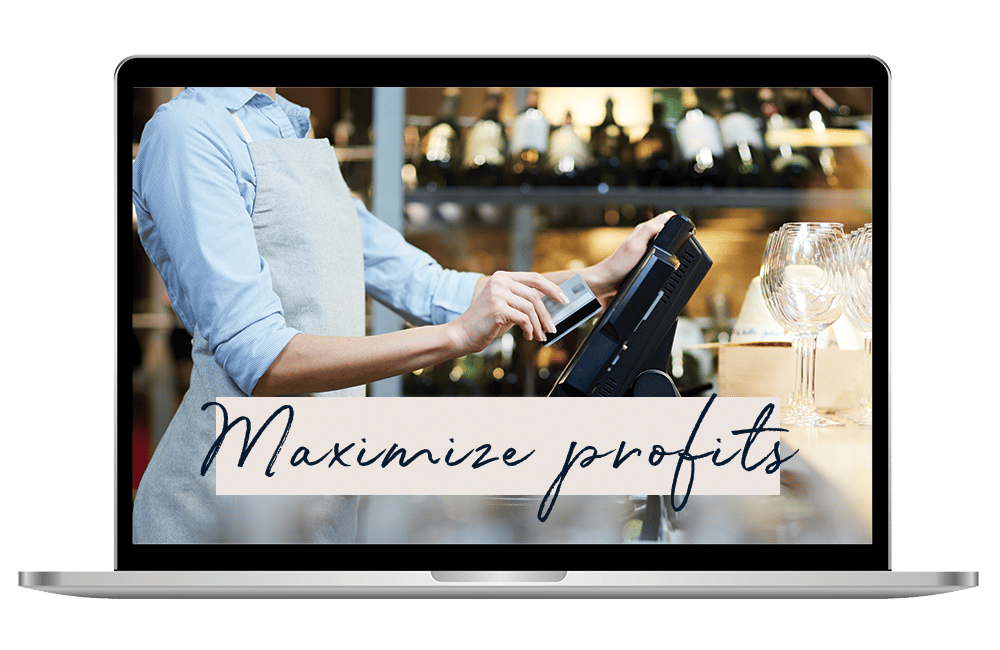
The three costly mistakes you could unknowingly be making?
Find out in this FREE guide and restaurant assessment specifically designed to reveal the unexpected hurdles standing between you and exponential business growth.
Thank You To Our Sponsors
Your operations base camp that scales standard procedures, trains your team, controls operations, and even manages food safety.
Get white glove service with FREE onboarding and implementation.
For a limited time only, popmenu is offering our listeners $100 off your first month plus an unchanging lifetime rate.
Request a DEMO:
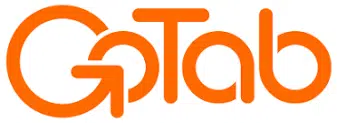
Want to become a podcast sponsor?
Please get in touch with Roger at roger@restaurantrockstars.com
